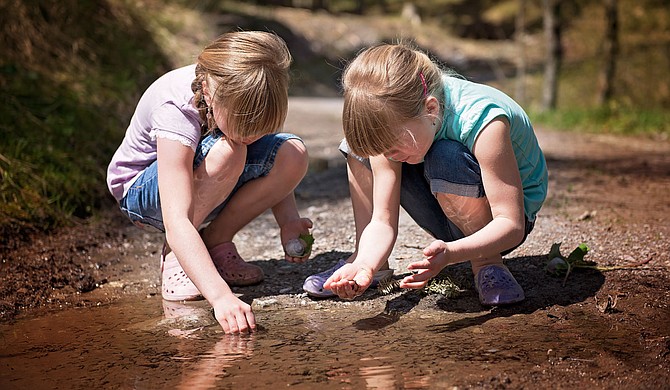Mississippi is rife with creeks and riverbeds full of tadpoles, perfect for the first of Baker’s list of ’70s-inspired summer activities for kids, growing frogs. Photo courtesy Pixbay
When I was a child in the 1970s, summers were far out. School ended just after Memorial Day, and we had three whole months to explore, and play, and have fun before heading back to the classroom after Labor Day. We played outside every day—TV was strictly regulated to after dinner, and only if homework and chores were done. The few available channels showed cartoons only on Saturday mornings from 6 a.m. to 10 a.m.
My dad was a master at coming up with fun things to do. We did most things as a family, or as a family with a few other neighborhood kids. We climbed trees, rode double on our bikes, had pocketknives, used needles and thread, baked in a hot oven and got filthy in the yard. But our parents weren't uptight about any of it, man. Everyone was feeling groovy!
So unpack your bell-bottoms and halter-tops and disco your way through this list of six fun, old-school things to do with your kids in these final days of summer vacation. What really sets these activities to the max is that these ideas are all things that can be done in ways that are safe, despite the current pandemic.
Idea #1:
Grow frogs. Find frogspawn—clumps of clear "jelly" containing hundreds of little black dots—in the shallows of still and slow-moving fresh water. In a large glass jar or small aquarium, collect some water, gravel, plants (with the roots) and a scoopful of the frogspawn or tadpoles. Over the course of six to 12 weeks, watch as the eggs hatch and the tadpoles grow legs, lose their tails and eventually become tiny frogs that you can then release back to nature.
Idea #2:
Backyard camping. Venture into the great beyond right in your own backyard. Set up the tent, unroll the sleeping bags, and roast hot dogs and marshmallows on sticks over an open fire. At night, turn off all the yard lights and sleep under a canopy of a million twinkling stars.
Idea #3:
Create a container herb garden. Local plant nurseries and other lawn and garden stores carry seeds and seedlings. Easy-to-grow herbs include basil, mint, chives, sage, coriander, parsley and rosemary. All you need is some potting soil, a few rocks for drainage, and clay pots (or use recycled materials like wide mouth jars and plastic milk jugs). Carefully plant seeds or seedlings and place in a sunny spot. Water daily and watch them sprout, usually within a week, and harvest your bounty.
Idea #4:
Scavenger hunt. Working backward, choose five or so locations throughout the house and yard. Craft clues, riddles or poems that lead the children to find and decipher the clues leading to the next destination. Feel free to come up with some fun prizes for your successful sleuths, like a new toy or an extra dessert.
Idea #5:
Research your family tree. Learning one's family background can help establish a stronger sense of identity. Dig out all the old photo albums. Call Grandma, Grandpa and Uncle Ralph to identify any people you do not know. Interview and record family members telling stories about what they used to do as children, and then use the photos and recorded interviews to create a family scrapbook, family-tree poster and/or an online family history.
Idea #6:
Assemble a Time Capsule. Start with a shoebox or other small container. Space permitting, allow each family member to put in five to 10 items, such as a favorite CD or DVD, report cards, birthday cards, a grocery receipt for one week's food, the front page of a newspaper, a copy of Grandma's secret cookie recipe, love letters and current photographs (write names and dates on the back). Seal the box with tape, label it "Time Capsule: Do Not Open Until 2030" and put it on a high shelf or in the attic, or if you're feeling especially whimsical, bury it in your own yard.
Michele D. Baker is a travel writer and photographer. For more on her work, or to browse more activity ideas, visit MicheleDBaker.com/1970.



Comments
Use the comment form below to begin a discussion about this content.
comments powered by Disqus